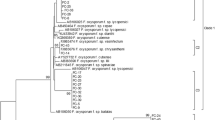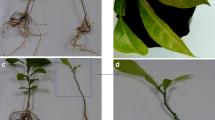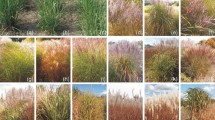Abstract
Random amplification of polymorphic DNA (RAPD-PCR) analysis was conducted on 48 isolates of Fusarium oxysporum f. sp. radicis-lycopersici (F.o.r.l.) from different geographic regions, representing all known vegetative compatibility groups (VCGs) except VCG 0097 and VCG 0099 and on eight isolates of F.oxysporum f. sp. lycopersici (F.o.l.), representing VCGs 0030, 0031, 0032 and 0033. Upon UPGMA (unweighted pair-group method with arithmetic averages) analysis of 86 RAPD-PCR markers generated by 16 informative primers and 44 markers obtained with eight microsatellite primers, a close relatedness was evident for F.o.r.l. isolates in VCGs 0090, 0092, 0096, and, to a lesser extent, for those in VCG 0093. Representatives of VCG 0091 formed a distinct group, while F.o.r.l. isolates in VCGs 0094 and 0098 were not distinguishable by the tested markers, most of which were also shared by F.o.l. isolates belonging to VCGs 0031 and 0033. F.o.l. isolates in VCGs 0030 and 0032 shared most of the molecular markers. The correlation between RAPD-PCR and microsatellite genetic distance was highly significant (R 2 = 0.77; P by Mantel test < 0.001). The molecular variability observed in both formae speciales is discussed in relation to the development of F.o.r.l.- and F.o.l.-specific diagnostic tools.
Similar content being viewed by others
References
MP Barve MP Haware MN Sainani PK Ranjekar VS Gupta (2001) ArticleTitlePotential of microsatellites to distinguish four races of Fusarium oxysporum f. sp. ciceri prevalent in India Theoretical and Applied Genetics 102 138–147 Occurrence Handle1:CAS:528:DC%2BD3MXitlKmtr0%3D
D Brayford (1996) ArticleTitleFusarium oxysporum f. sp. radicis-lycopersici. IMI Descriptions of fungi and bacteria Mycopathologia 133 61–63
G Cai LR Gale RW Schneider HC Kistler RM Davis KS Elias EM Miyao (2003) ArticleTitleOrigin of race 3 of Fusarium oxysporum f. sp. lycopersici at a single site in California Phytopathology 93 1014–1022 Occurrence Handle18943868 Occurrence Handle1:STN:280:DC%2BD1cjkt1KitQ%3D%3D
C Carbonell D Cifuentes J Tello JL Cenis (1994) ArticleTitleDifferentiation of Fusarium oxysporum f. sp. lycopersici and F.o. f. sp. radicis-lycopersici and its detection in plant by RAPD markers Boletin de Sanidad Vegetal 20 919–926
RA DeScenzo TC Harrington (1994) ArticleTitleUse of (CAT)5 as a DNA fingerprinting probe for fungi Phytopathology 84 534–540 Occurrence Handle1:CAS:528:DyaK2MXisVCqtA%3D%3D
P Di Primo G Cartia T Katan (2001) ArticleTitleVegetative compatibility and heterokaryon stability in Fusarium oxysporum f. sp. radicis-lycopersici from Italy Plant Pathology 50 371–382
KS Elias RW Schneider (1992) ArticleTitleGenetic diversity within and among races and vegetative compatibility groups of Fusarium oxysporum f. sp. radicis-lycopersici as determined by isozyme analysis Phytopathology 82 1421–1427 Occurrence Handle1:CAS:528:DyaK3sXhs1Gjs7o%3D
KS Elias D Zamir T Lichtman-Pleban T Katan (1993) ArticleTitlePopulation structure of Fusarium oxysporum f.sp. lycopersici: restriction fragment length polymorphisms provide genetic evidence that vegetative compatibility group is an indicator of evolutionary origin Molecular Plant-Microbe Interactions 6 565–572 Occurrence Handle1:CAS:528:DyaK2cXis1Gmurs%3D
LR Gale T Katan HC Kistler (2003) ArticleTitleThe probable center of origin of Fusarium oxysporum f. sp. lycopersici VCG 0033 Plant Disease 87 1433–1438
J Geistlinger K Weising WJ Kaiser G Kahl (1997) ArticleTitleDetection of microsatellite fingerprint markers and their Mendelian inheritance in Ascochyta rabiei Molecular and General Genetics 256 298–305 Occurrence Handle9393455 Occurrence Handle1:CAS:528:DyaK2sXnsFyjtbY%3D
J Hantula M Dusabenyagasani RC Hamelin (1996) ArticleTitleRandom amplified microsatellites (RAMS): A novel method for characterizing genetic variation within fungi European Journal of Forest Pathology 26 159–166
WR Jarvis (1988) ArticleTitleFusarium crown and root rot of tomatoes Phytoprotection 69 49–64
WR Jarvis H Thorpe (1976) ArticleTitleSusceptibility of Lycopersicon species and hybrids to the foot and root rot pathogen Fusarium oxysporum Plant Disease Reporter 60 1027–1031
S Kalman D Zamir T Katan (2001) ArticleTitleRestriction fragment length polymorphism (RFLP) analysis reveals that Fusarium oxysporum f. sp. radicis-lycopersici is polyphyletic Phytoparasitica 29 254–255
T Katan J Katan (1999) ArticleTitleVegetative compatibilty grouping in Fusarium oxysporum f. sp. radicis-lycopersici from the UK, the Netherlands, Belgium and France Plant Pathology 48 541–549
T Katan D Zamir M Sarfatti J Katan (1991) ArticleTitleVegetative compatibility groups and subgroups in Fusarium oxysporum f. sp. radicis-lycopersici Phytopathology 81 255–262 Occurrence Handle1:CAS:528:DyaK3MXks1yjtbw%3D
T Katan E Shlevin J Katan (1997) ArticleTitleSporulation of Fusarium oxysporum f. sp. lycopersici on stem surfaces of tomato plants and aerial dissemination of inoculum Phytopathology 87 712–719 Occurrence Handle18945093 Occurrence Handle1:STN:280:DC%2BD1cjjvVeqsg%3D%3D
T Maniatis EF Fritsch J Sambrook (1982) Molecular Cloning: A Laboratory Manual Cold Spring Harbor Laboratory Cold Spring Harbor, USA
N Mantel (1967) ArticleTitleThe detection of disease clustering and a generalized regression approach Cancer Research 27 209–220 Occurrence Handle6018555 Occurrence Handle1:STN:280:CCiD1MzgsVY%3D
JG Menzies C Koch F Seywerd (1990) ArticleTitleAdditions to the host range of Fusarium oxysporum f. sp. radicis-lycopersici Plant Disease 74 569–572
JJ Mes J Doorn Particlevan EJA Roebroeck E Egmond Particlevan J Aartrijk Particlevan PM Boonekamp (1994) ArticleTitleRestriction fragment length polymorphisms, races and vegetative compatibility groups within a worldwide collection of Fusarium oxysporum f. sp. lycopersici. Plant Pathology 43 362–370
W Meyer TG Mitchell EZ Freedman R Vilgalys (1993) ArticleTitleHybridization probes for conventional DNA fingerprinting used as single primers for the polymerase chain reaction to distinguish strains of Cryptococcus neoformans Journal of Clinical Microbiology 31 2274–2280 Occurrence Handle8408543 Occurrence Handle1:CAS:528:DyaK2cXhsFOm
Q Migheli O Friard D Tedesco ParticleDel MR Musso ML Gullino (1996) ArticleTitleStability of transformed antagonistic Fusarium oxysporum strains in vitro and in soil microcosms Molecular Ecology 5 641–649 Occurrence Handle1:CAS:528:DyaK28XmsValsb8%3D
Nei M and Li WH (1979) Mathematical model for studying genetic variation in terms of restriction endonucleases. Proceedings of the National Academy of Sciences USA 76: 5269–5273
Y Rekah D Shtienberg J Katan (2001) ArticleTitlePopulation dynamics of Fusarium oxysporum f. sp. radicis-lycopersici in relation to the onset of Fusarium crown and root rot of tomato. European Journal of Plant Pathology 107 367–375
UL Rosewich RE Pettway T Katan HC Kistler (1999) ArticleTitlePopulation genetic analysis corroborates dispersal of Fusarium oxysporum f. sp. radicis-lycopersici from Florida to Europe. Phytopathology 89 623–630 Occurrence Handle18944673 Occurrence Handle1:STN:280:DC%2BD1cjjsl2ksg%3D%3D
RC Rowe JD Farley DL Coplin (1977) ArticleTitleAirborne spore dispersal and recolonization of steamed soil by Fusarium oxsporum in tomato greenhouses Phytopathology 67 1513–1517 Occurrence Handle10.1094/Phyto-67-1513
D Simioniuc R Uptmoor W Friedt F Ordon (2002) ArticleTitleGenetic diversity and relationships among pea cultivars revealed by RAPDs and AFLPs Plant Breeding 121 429–435 Occurrence Handle1:CAS:528:DC%2BD38Xpslegsb4%3D
GL Sun O Diaz B Salomon R Bothmer Particlevon (1999) ArticleTitleGenetic diversity in Elymus caninus as revealed by isozyme, RAPD, and microsatellite markers Genome 42 420–431 Occurrence Handle10382290 Occurrence Handle1:CAS:528:DyaK1MXkt1Chtbk%3D
Y Peer ParticleVan de R De Wachter (1994) ArticleTitleTREECON for Windows: a software package for the construction and drawing of evolutionary trees for the Microsoft Windows environment Computer Applications in the Biosciences 10 569–570 Occurrence Handle7828077
K Weising RG Atkinson RC Gardner (1995) ArticleTitleGenomic fingerprinting by microsatellite-primed PCR: a critical evaluation PCR Methods Applications 4 249–255 Occurrence Handle1:CAS:528:DyaK2MXltFaqtL0%3D
J Welsh M McClelland (1990) ArticleTitleFingerprinting genomes using PCR with arbitrary primers Nucleic Acids Research 18 7213–7218 Occurrence Handle2259619 Occurrence Handle1:CAS:528:DyaK3MXls12jsQ%3D%3D
JGK Williams AR Kubelik KJ Livak JA Rafalski SV Tingey (1990) ArticleTitleDNA polymorphisms amplified by arbitrary primers are useful as genetic markers Nucleic Acids Research 18 6531–6535 Occurrence Handle1979162 Occurrence Handle1:CAS:528:DyaK3MXjslWmsA%3D%3D
Author information
Authors and Affiliations
Corresponding author
Rights and permissions
About this article
Cite this article
Balmas, V., Scherm, B., Di Primo, P. et al. Molecular characterisation of vegetative compatibility groups in Fusarium oxysporum f. sp. radicis-lycopersici and f. sp. lycopersici by random amplification of polymorphic DNA and microsatellite-primed PCR. Eur J Plant Pathol 111, 1–8 (2005). https://doi.org/10.1007/s10658-004-1602-9
Accepted:
Issue Date:
DOI: https://doi.org/10.1007/s10658-004-1602-9




